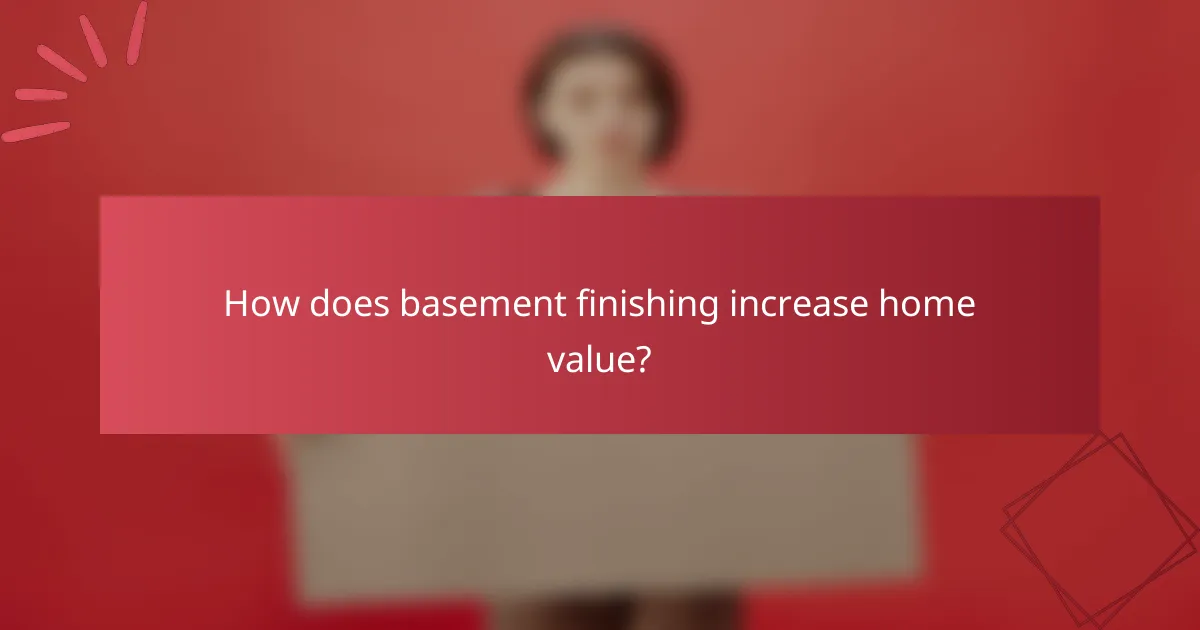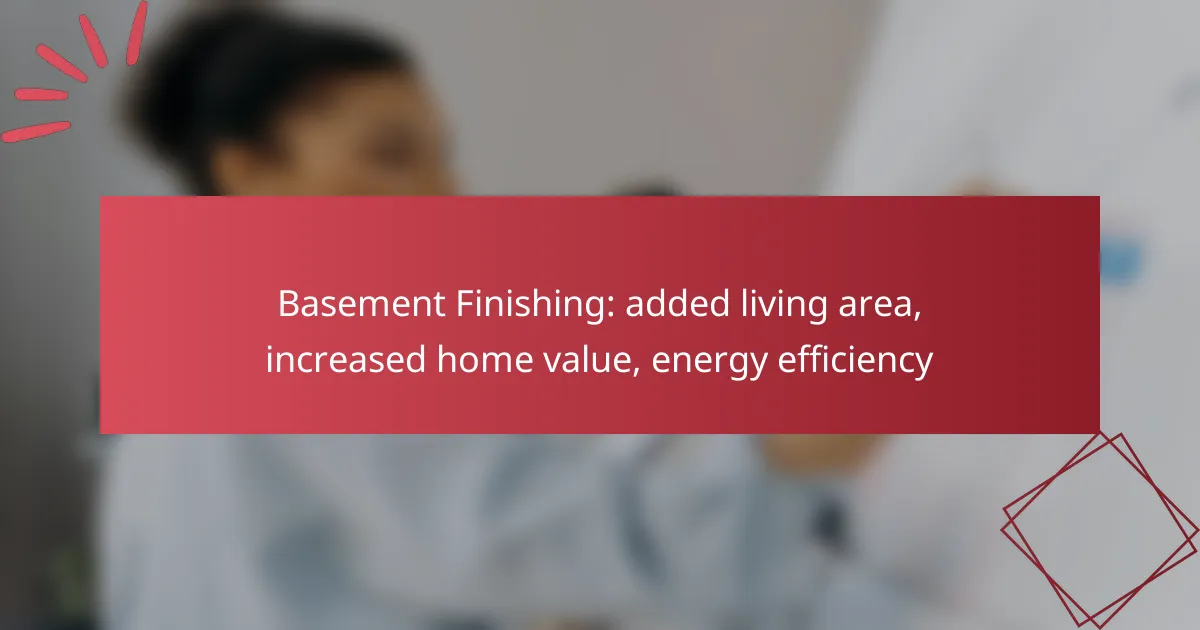Finishing a basement is an excellent way to transform unused space into valuable living areas, significantly enhancing your home’s appeal and market value. This renovation not only increases the overall square footage but also boosts energy efficiency and offers potential rental income, making it a smart investment for homeowners looking to improve functionality and financial return.

How does basement finishing increase home value?
Finishing a basement can significantly enhance a home’s value by transforming unused space into livable areas. This added living space not only increases the overall square footage but also improves the home’s appeal and functionality, making it more attractive to potential buyers.
Increased square footage
Finishing a basement effectively adds square footage to your home, which is a key factor in real estate valuation. Homes with more livable space typically command higher prices, often increasing property value by a notable percentage. For example, adding a finished basement can increase the total square footage by 20-30%, depending on the layout and design.
When considering basement finishing, ensure that the new space adheres to local building codes and regulations, as this can affect its value. Proper permits and inspections can prevent future issues that may detract from the home’s worth.
Improved aesthetics
A finished basement can dramatically enhance the overall aesthetics of a home. By using quality materials and thoughtful design, homeowners can create inviting spaces that appeal to buyers. Features like modern lighting, stylish flooring, and attractive wall finishes can make the basement feel like an integral part of the home.
Investing in aesthetic improvements not only boosts value but also enhances the living experience for current residents. Consider incorporating elements such as built-in shelving, cozy seating areas, or even a small bar to elevate the space’s appeal.
Enhanced functionality
Finishing a basement increases the functionality of a home by providing versatile spaces that can serve various purposes. Homeowners can create additional bedrooms, entertainment areas, or even home offices, catering to different needs and lifestyles. This flexibility is particularly appealing in today’s market, where buyers often seek multifunctional living spaces.
When planning for functionality, think about the specific needs of your household. For instance, if you have children, a playroom or a family room may be ideal. If you work from home, a quiet office space can add significant value and utility.

What are the benefits of finishing a basement?
Finishing a basement offers several advantages, including increased living space, enhanced energy efficiency, and the potential for rental income. These benefits can significantly improve both the functionality and value of a home.
Added living space
Finishing a basement transforms an underutilized area into valuable living space, which can be used for various purposes such as a family room, home office, or guest suite. This additional square footage can enhance the overall comfort of your home.
When planning your basement layout, consider how the space will be used and ensure it meets local building codes. A well-finished basement can add significant square footage, potentially increasing your home’s market value by a notable percentage.
Increased energy efficiency
A finished basement can improve your home’s energy efficiency by providing better insulation and reducing heat loss. Properly insulating walls and floors can help maintain a consistent temperature, leading to lower heating and cooling costs.
Investing in energy-efficient windows and doors for your basement can further enhance its efficiency. Look for products with good energy ratings to ensure you maximize savings on utility bills while creating a comfortable living environment.
Potential rental income
Finishing a basement can create an opportunity for rental income, especially if you design it as a separate living unit with its own entrance. This can be an attractive option for homeowners looking to offset mortgage payments or generate passive income.
Before renting out your finished basement, check local regulations regarding rental properties. Ensure that the space complies with safety standards and zoning laws to avoid any legal issues. A well-finished basement can command a competitive rental price, depending on your location and amenities offered.

What are the costs associated with basement finishing in the US?
The costs associated with basement finishing in the US can vary widely depending on several factors, including the size of the space and the quality of materials used. Homeowners typically spend anywhere from low tens of thousands to higher amounts for a complete renovation.
Average cost per square foot
The average cost for finishing a basement generally falls between $30 to $100 per square foot. This range can fluctuate based on the complexity of the project and the materials selected. For example, a basic finish may cost around $30 to $50 per square foot, while high-end finishes can reach $100 or more.
Factors affecting pricing
Labor costs can vary by region, with urban areas typically charging more than rural locations. It’s advisable to obtain multiple quotes from contractors to ensure competitive pricing.
Cost of permits and inspections

What are the steps to finish a basement?
Finishing a basement involves several key steps that transform the space into a functional living area. The process typically includes planning and design, framing and insulation, electrical and plumbing installation, and finally, adding finishing touches.
Planning and design
The planning and design phase is crucial for a successful basement finish. Start by determining the purpose of the space, whether it will be a family room, guest suite, or home office. Create a layout that maximizes the available square footage while ensuring compliance with local building codes.
Consider factors such as natural light, ventilation, and access to utilities. Sketch out your ideas and, if necessary, consult with a designer or contractor to refine your plans and ensure they are practical and achievable within your budget.
Framing and insulation
Framing is the next step, where you build the walls and define the layout of the basement. Use treated lumber for any wood that will be in contact with concrete to prevent moisture damage. Ensure that the framing is level and square to create a solid structure for the walls and ceiling.
Insulation is essential for energy efficiency and comfort. Use fiberglass batts or foam board insulation to keep the space warm in winter and cool in summer. Check local building codes for required R-values to ensure adequate insulation levels.
Electrical and plumbing installation
Once the framing and insulation are in place, it’s time to install electrical and plumbing systems. Hire a licensed electrician to handle wiring for lighting, outlets, and any appliances you plan to include. Ensure that all installations comply with local electrical codes.
If your basement will have a bathroom or wet bar, plumbing installation is necessary. This may involve running new pipes and ensuring proper drainage. Again, hiring a licensed plumber is recommended to meet all regulations and avoid future issues.
Finishing touches
The final step in finishing your basement involves adding the finishing touches that make the space livable. This includes drywall installation, painting, flooring, and installing fixtures like lights and cabinetry. Choose materials that are moisture-resistant, especially for flooring and paint, to prevent mold growth.
Consider adding features such as built-in shelving or a bar area to enhance functionality and aesthetics. Finally, ensure that all work meets local building codes and obtain any necessary inspections to certify that your finished basement is safe and compliant.

What are the best materials for basement finishing?
The best materials for basement finishing focus on moisture resistance, durability, and energy efficiency. Selecting the right materials can enhance the living space, improve comfort, and increase the overall value of your home.
Moisture-resistant drywall
Moisture-resistant drywall, often referred to as green board or blue board, is specifically designed for areas prone to humidity. This type of drywall has a special coating that helps prevent mold and mildew growth, making it ideal for basement environments.
When installing moisture-resistant drywall, ensure proper sealing and taping to further protect against moisture infiltration. Consider using a vapor barrier behind the drywall to enhance protection, especially in regions with high groundwater levels.
Durable flooring options
Choosing durable flooring for your basement is crucial, as it needs to withstand potential moisture and heavy foot traffic. Options like vinyl plank flooring, tile, and sealed concrete are popular due to their resilience and ease of maintenance.
Vinyl plank flooring is particularly appealing for basements, as it is waterproof and available in various styles. Tile offers a more traditional look and is also water-resistant, while sealed concrete provides a modern, industrial aesthetic that is easy to clean.
Energy-efficient insulation
Energy-efficient insulation is vital for maintaining comfortable temperatures in a finished basement. Insulating walls and ceilings with materials like foam board or spray foam can significantly reduce energy costs by preventing heat loss.
When selecting insulation, consider R-value, which measures thermal resistance. Aim for insulation with a higher R-value for better energy efficiency. Additionally, ensure that insulation is installed correctly to avoid gaps that could lead to drafts and moisture issues.

How to choose a contractor for basement finishing?
Choosing a contractor for basement finishing involves assessing their qualifications, experience, and customer feedback. Prioritize contractors with a solid reputation and clear communication to ensure your project meets expectations.
Check credentials and reviews
Start by verifying the contractor’s credentials, including licenses, insurance, and certifications. Many states require specific licenses for remodeling work, so ensure your contractor meets these legal requirements.
Additionally, read reviews on platforms like Google, Yelp, or Angie’s List. Look for feedback on their past projects, responsiveness, and overall customer satisfaction to gauge their reliability.
Request detailed estimates
When requesting estimates, ask for a breakdown of costs, including labor, materials, and any potential additional fees. A detailed estimate helps you understand the financial scope of the project and prevents unexpected expenses later on.
Compare estimates from multiple contractors to identify reasonable pricing. Be cautious of significantly low bids, as they may indicate lower quality work or hidden costs. Aim for estimates that reflect a balance of quality and affordability.



